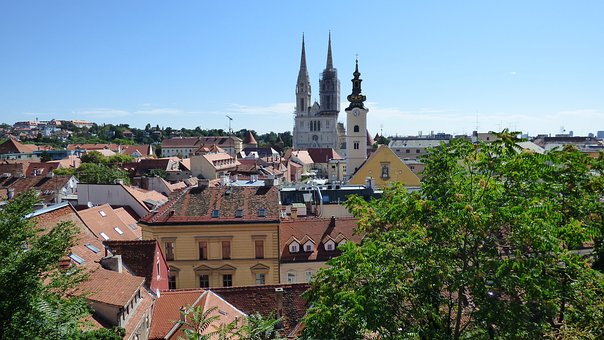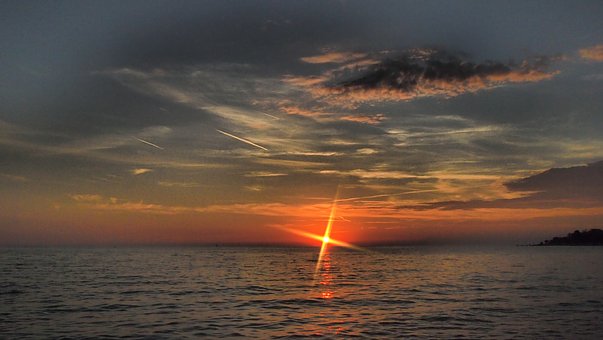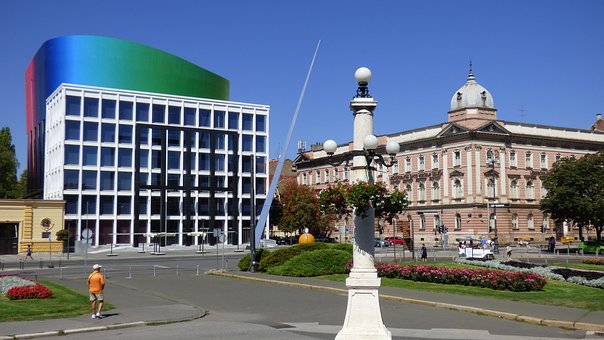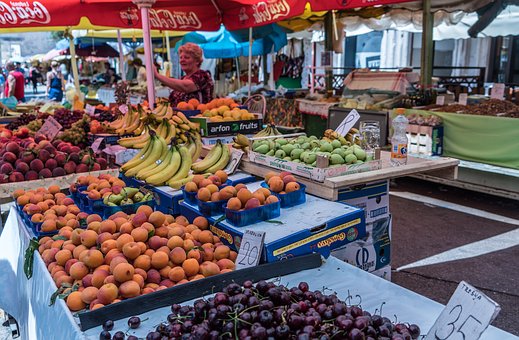Backpacking in Croatia
Croatia, the Eastern European country with a long coast at the Adriatic Sea offers you various natural landscapes with gentle hills in Istria, mountains in the Dinaric Alps and dreamlike beaches at the coast of Dalmatia. The territory of Croatia includes more than 1000 islands. There are many attractive national parks, some of which are located on the islands directly by the sea or in the karst landscape of the hinterland.
Croatia covers an area of 56,542 square kilometres and borders Slovenia, Hungary, Serbia, Bosnia and Herzegovina and Montenegro. Around 790,000 people live in the state capital Zagreb. A third of the country is covered with forests where deciduous trees and conifers grow. In the coastal areas of Croatia you will find Mediterranean trees such as pines and macchia. During a ramble through the landscape you will come across wetlands, where rare species of water lilies make the landscape unique.
The animal world is just as varied as the flora. Large predators such as wolves, lynxes, golden jackals and brown bears can be found in the mountain regions. You will also find griffon vultures, golden eagles and snake eagles, cormorants, bald eagles, land, swamp and sea turtles, lizards, geckos and snakes. Since Croatia became independent, a lot of money has been invested in infrastructure. Roads and motorways are being built and funds are being invested in other infrastructure projects to attract visitors to the country and make their stay as pleasant as possible.
In addition to fascinating landscapes and a breathtaking coastline, you will find relics from ancient times, many of which are UNESCO World Heritage Sites. The old town of Dubrovnik, the medieval tombstones of Stecci, the historic town of Trogir, the plain of Stari Grad and the Cathedral of St. Jacob in Sibenik are among the destinations you must have seen.
Travelling in Croatia is possible by land, air and water in order to get from one place to another. Backpacking through Croatia you will encounter a continental climate in the interior. On the Adriatic coast, on the other hand, there are maritime conditions. They offer you dry summers and a mild, warm winter. Snow and cold in the winter months is not uncommon in the mountain regions.
You can get money at the cash machines of the banks, both with the EC card, as well as with credit cards. Since there are often additional costs for withdrawing cards, you should use a credit card without additional costs for withdrawals abroad. Talking to Croats in the local language is quite difficult. However, you will get along very well with German and English as well as with hands and feet everywhere. You won’t starve either, because there are different kinds of food in every village.
Culture in Croatia
Croatia belongs to the former multi-ethnic state of Yugoslavia, which was ruled by Tito and was an artificial state. He ruled over the whole country until his death. Subsequently, the multi-ethnic state gradually disintegrated into its individual states in order to exist as independent countries. After the state community of Serbia and Montenegro dissolved in 2006, Yugoslavia disappeared completely from the map. Only the individual states remain, where Croatia also belongs to.
The country has evolved since the dissolution of the artificial state structure. In contrast to the past, people today live much better than in former times. Croatia is in the area of tension between several cultural circles. Because the neighbouring countries have influence on the entire social and political life in Croatia.
Since many different peoples are united in the country, you also come across different cultures, which make themselves felt with their traditions everywhere in the country. But despite all these differences, you will be warmly welcomed and welcomed. A special feature of Croatia is the social diversity that you can immerse yourself in during your backpacker trip. Besides Croats, Serbs, Slovenes, Bosniaks, Czechs, Italians, Hungarians and Albanians live in the country, who shape the cultural and economic life.
More Backpacking Information about Croatia
In terms of prices, Croatia is generally below the European average. In the tourist centres, prices are generally higher. In rural areas there is a lower price level. With 50 to 70 Euro per day you can make a living.
In Croatia you will encounter a breathtaking cultural diversity. A third of the country is covered by forests and there are hilly and mountainous landscapes that invite you to extensive hikes. In winter it gets really cold in the mountains. Therefore, depending on your plans, you should consider the right travel time.
There are several ways to find a hostel in Croatia. So you can find nice bargains to stay overnight for 10 to 13 euros. On average you pay for a bed in a hostel between 18 and 20 euros. In the tourist areas it can get much more expensive.
The Croatian cuisine is very varied and offers meat and fish specialities, hearty soups, delicious ham and cheese specialities as well as great wines and herb schnapps. Gourmets experience a true gourmet paradise. Due to the diversity of the population and cultural differences, you will experience a multicultural diversity, which also has a great influence on the country’s cuisine.
As a German citizen you do not need a visa, as Croatia belongs to the European Union. What else you need to know as a backpacker in Croatia can be found under Visa & Vaccinations.
Backpacker Budget in Croatia
Croatia has long ceased to be a cheap travel destination. Travelling and living with backpacking is, especially in the touristically heavily frequented regions, cities, towns and villages and with the admission prices for sights, often on Central European. This is also noticeable in the prices for accommodation and the use of public transport.
However, the price/performance ratio differs from the usual Central European standard. The currency in Croatia is the Croatian Kuna. Sometimes you can also pay with Euro. As a rule, you can make ends meet on your backpacker trip with 50 to 70 euros a day.
For travelling in the country there are different possibilities available to you, which you can use to get from A to B. If you want to rent a car, you can use the new, modern motorway network. However, you should keep in mind that you will have to pay tolls on the well-developed roads.
On the A1 motorway from Zagreb to Zandar you pay around 15 euros, from Zagreb to Split around 24 euros and from Zagreb to Ravca around 26 euros. A litre of fuel costs around 1.30 euros. If you want to eat in a restaurant, you should be prepared for a main course with a drink costing between 18 and 25 euros if you value good cuisine and pleasant service. On average, however, you can also get by with 8 to 10 euros for food.
Taxi driving in Croatia
Probably the most expensive way to travel backpacking in Croatia is by taxi. In the first place are pre-booked transfers, where you pay between 1.20 and 1.50 euros for the driven kilometer. For example, if you use a taxi in Pula to get from A to B, you pay 5 euros for the first 3 kilometres and 1.10 euros for each additional kilometre driven. A surcharge of 20 percent is charged for night journeys and on Sundays and public holidays. Bus travel in Croatia is a much cheaper alternative.
Bus travel in Croatia
Buses take you on your backpacker trip through the whole country and to almost every city. The bus connections are quite reliable as far as travel times are concerned, so you can plan quite well. To plan your costs for a bus trip, simply visit getbybus and enter your desired route to calculate the cost of the bus trip.
Domestic fares in Croatia
There is only one international airline, Croatia Airlines, which offers domestic flights. The prices are correspondingly expensive. The flights include Airbus A 319 and A 320. All flights are via Zagreb. There are no direct flights to other major cities. From Zagreb there are flights to Dubrovnik, Pula, Split and Zadar. The cheapest price for a non-stop flight is 45 euros. For a connecting flight you pay around 60 euros if you get a cheap flight.
Rail travel in Croatia
Travelling by train is difficult in Croatia, because the scenic conditions do not allow for a well-developed railway network. A real alternative is the train only if you want to travel from Zagreb to the bigger coastal cities like Rijeka, Split or Zadar.
Boating in Croatia
To the offshore islands ferries go regularly, several times a day, which you can use for backpacking. The crossings are quite cheap and pleasant. The largest shipping company in Croatia is Jadrolinija. It offers ferry connections along the Adriatic coast. So you can reach Rijeka, Split or Dubrovnik with the ship completely relaxed, without having to put up with expensive toll fees and long, stressful travel times. For a distance from Dubrovnik to Split with a catamaran you pay about 30 Euro.
Backpacker Route in Croatia
As a backpacker travelling through Croatia, you will experience a culturally and scenically diverse country with gentle hills, large forest areas, the mountain ranges of the Dinaric Alps, dreamlike coasts and a multitude of offshore islands. Therefore a trip is very versatile, because you can enjoy action and adventure as well as relaxation and recreation.
There are numerous hiking and trekking trails, where nature lovers get their money’s worth. In a beautiful landscape you can discover breathtaking waterfalls and lakes. From the hills you have a great view into the distance. Beautiful bays and beaches, untouched by tourism, are little paradises where you can find peace and relaxation and simply relax. What should you have definitely seen on your backpacker tour through Croatia?
Route 1: The classic (15-20 days)
- 2 days Zadar. Explore the beautiful Old Town and enjoy the flair of the city.
- 3 days exploring Split and discovering unique architecture in the Old Town.
- Experience 3 days island Korcula and the places Vela Luka, Racisce and Korula city.
- 3 days Dubrovnik in the city life and the culture immerse. Visit the old town.
- 2-3 days Kijevo and the highest mountain of Croatia, the Dinara with 1831 meters climb.
- 3 day visit the island Krk and dive into the scenic beauty.
- 2 day in Rijeka on a museum and church tour to discover undreamt-of art treasures.
- 2 day Zagreb experience the pulsating capital and discover breathtaking buildings.
Route 2: Backpacker Intensive Trip (up to 30 days and more)
- 2 days in Zadar. Explore the beautiful Old Town and enjoy the flair of the city.
- 3 days exploring Split and discovering unique architecture in the Old Town.
- 3 days to explore Korcula Island and the towns of Vela Luka, Racisce and Korula City.
- 3 days in Dubrovnik to immerse yourself in city life and culture. Visiting the old town is the order of the day.
- 2-3 days Kijevo and the highest mountain of Croatia, the Dinara with 1831 meters climb.
- 3 days visit the island of Krk and immerse yourself in the beauty of the landscape.
- 3 days on the island of Cres. Discover breathtaking beaches, Lake Vrana and Pogana.
- 2 days in Pula. Discover ruins from Roman times and immerse yourself in city life.
- 2 days in Rijeka, discover unimagined art treasures on a tour of museums and churches.
- 4 days exploring Hum and the National Park Plitvice Lakes and enjoying unique nature experiences.
- 3 days Zagreb experience the pulsating capital and discover breathtaking buildings.
Travel times in Croatia
The best travel time for your backpacking trip through Croatia depends on what you want to do. Basically you can travel to Croatia all year round. If you want to explore the varied landscape and enjoy the Adriatic coast and the sea at the same time, summer is the best time to travel. In July and August it gets very hot with temperatures over 30°C. You will meet many tourists and you will sweat a lot during different excursions and hiking tours.
It is less hot in the months of May. June, September and October, which offer themselves quasi for trekking and hiking tours. The temperatures are very pleasant and lie between 22° and 27°C. The winter months are also very attractive if you want to combine your backpacker trip with skiing. Especially in the high altitudes beautiful slopes are waiting for you. In the summer months rainwear should not be missing in your luggage, because there can be some rainy days from time to time.
Backpacker accommodations in Croatia
Croatia is no longer a cheap travel destination. This is also reflected in the prices for accommodation. There are a variety of accommodation options that you can use on your backpacker trip, but you will soon notice that prices vary greatly. So you’ll pay a lot more for a room in a tourist area than in a remote area, on the outskirts of town or in a smaller village. For special luxury you pay a lot of money. Thus the prices for a room in a 5-star hotel are fast with approximately 150 euro and more. It becomes more expensive, if you would like to use such a room in the high season.
But there are also inexpensive alternatives. Especially in the bigger cities you can stay comfortably in hostels. Hostelworld offers you more than 205 hostels in Croatia. A look at the page will quickly give you information about the costs for an overnight stay in different cities. According to that you pay for a bed on average the following prices:
- Split 10 -17 Euro
- Dubrovnik 16 -21 Euro
- Zagreb 10 -25 Euro
- Hvar 12 -15 Euro
- Zadar 12 – 20 Euro
- Pula 22 Euro
- Plitvice Lakes 20 Euro
- Rijeka 18 Euro
- Sibenik 19 Euro
- Novalja 25 Euro
- Krk 15 Euro
Prices can vary considerably from hostel to hostel. Therefore you should take your time to find a reasonable price for your accommodation and to keep your expenses within reasonable limits. A nice alternative are also small hotels directly in the city centres or motels.
Motels on exit roads and motorways
Motels are an alternative to staying overnight, even if you are not travelling with a rental car, but travelling from one place to another by thumb while backpacking. Especially on the A1 there are some houses to be found. They are well equipped, have a good WLAN and sometimes a pool. With a lot of luck, you pay around 40 euros for one overnight stay. Often, however, the prices rather settle at 60 to 80 euros. It will be cheaper if you look for small hotels in the city centres. You get a certain standard and don’t have long ways to explore the city.
Camping in Croatia
Camping is a nice alternative if you love the romance of tents and campfires. There are a number of great campsites in Croatia where you can spend the night directly by the sea, by a lake or by waterfalls in the great outdoors. At over 500 campsites you can pitch your tent under shady pine trees, in hidden bays, on sandy beaches or in national parks.
There are also so-called camping parks, where you can rent a cabin and enjoy a lot of luxury. But that costs a lot. But if you have a tent in your luggage, camping is worth it, as you pay between 11 and 19 Euros per night for two people. Freedom, campfire romance and a unique lifestyle are included.
Backpacker Trips & Tips in Croatia
Croatia has so much to offer you on your backpacker tour of the country. Breathtaking landscapes, quiet lakes, raging waterfalls, dreamy harbour towns, sandy beaches, large forests, bizarre mountain ranges and secluded bays where you can immerse yourself in the uniqueness of the flora and fauna.
On the traces of history you will come across impressive buildings, impressive churches, ruins from Roman times, which gracefully shape the townscape and landscape. During your backpacker trip you should discover the country away from the tourist areas. Locals will be happy to give you advice and insider tips and recommend places that are not listed in any travel guide and are therefore all the more worth seeing.
Backpacker Highlights in Croatia
Among the unique backpacker highlights in Croatia are the Old Town of Dubrovnik, the Palace of Emperor Diocletian and the Old Town in Split, the historic city centre of Porec and the Euphrasius Basilica as well as the historic city of Trogir. Everywhere you come into close contact with the past and culture, as every building and every path has its own story to tell.
The Stari Grad plain is a cultural landscape located on the island of Hvar in the Adriatic Sea. It encounters a coherent system of land use and agricultural colonisation by the Greeks from the 4th century BC. The vastness of the vineyards and olive groves dominate the landscape. Impressive is not only the lush green, but also the interesting, geometric structure that characterizes the landscape.
Another highlight of your backpacker trip awaits you in the Plitvice Lakes National Park, where enchanting lakes can be found embedded in the landscape. The lakes are connected by waterfalls and are surrounded by unique nature.
Backpacker insider tips in Croatia
A scenic dream awaits you in Omis, which is not far from Split and is a real insider tip. In the breathtaking landscape with a fantastic view you can walk wonderfully. Omis is also a good starting point for unique canoe tours and extensive beach days to relax and enjoy.
A real insider tip is the Blue Grotto of Bisevo. It is a cave on the east side of Bisevo Island. On sunny days and in a calm sea you can dive several meters below sea level in sunlight and discover the inside of the cave through the natural opening. If you don’t want to dive, you can also enter the Blue Grotto through an additional artificial entrance above sea level and experience its uniqueness up close.
Food & Drinks in Croatia
Croatia’s cuisine has Slavic roots and is influenced by Turkish and Hungarian cuisine as well as the Viennese culinary school. Mainly freshwater fish, meat products and vegetables dominate the different dishes. The menus of Zagreb’s gastronomy include the so-called Purgur cuisine, which combines Austrian and Hungarian cooking traditions. There are dishes such as noodles with onions and cheese or the famous Kaiserschmarrn.
The food culture is European, so you don’t have to get involved in any exotic experiments. In addition to the traditional dishes offered in the various restaurants, you will also find well-known fast food chains and snack bars in the larger cities to satisfy your hunger. The markets offer a wide range of fresh, delicious fruit.
For 0.5 litres of local beer you pay around 2 euros in the restaurant, for 0.5 litres of local wine between 4 and 6 euros and a cappuccino for 1 euro. In the tourist areas you have to reckon with 20 to 60 percent higher prices. It will be much cheaper if you buy at the supermarket.
Food in Croatia
There are many typical Croatian specialities. In Northern Croatia you should try Purica s Mlincima (baked turkey with mazen), Krvavice (fried black pudding), Strukli (salty pumpkin cake with meat cheese), Pecenice (smoked ham from the neck) and Odojak (suckling pig).
Typical dishes for Dalmatia are pasticada (a Mediterranean version of goulash with noodles or gnocchi), bijeli/crni rizot (Dalmatian risotto, partly dyed with ink from squids), salata od hobotnice (octopus salad) and brudet (a Dalmatian stew). Another delicacy is Paski Sir, one of the world’s best cheeses made from sheep’s milk and dried in front of the bora.
In the coastal region, freshly caught fish, mussels, octopus and crabs as well as lamb, pasta, chestnuts and olives are on the plate. As a true gourmet in Croatia you are guaranteed to get your money’s worth.
Drinking in Croatia
A typical drink are the different wines whose vines come from Dalmatia, Istria and the Kvarner Bay. The red wines of the coastal regions and islands are particularly delicious. So on your backpacker trip you can enjoy the unique taste of Merlot, Plavac, Postup, Teran and Kabernet. If you prefer white wine, you can’t avoid Malvazia, Pinot, Zlahtina, Muskat and Kujundzusa.
The Croatian beer “Pivo” is very similar in taste to the German beer and just right for a warm summer evening. You should definitely try Riječko Pivo, the dark Tomislav Pivo, Staro Češko Pivo, Ožujsko Pivo and Karlovačko. They are among the best known types of beer.
You can experience true coffee enjoyment in traditional coffee houses, where coffee is boiled in small copper pots with lots of sugar and then served in small cups. Strong as a Mokka and very tastefully you experience this singular benefit.
Backpacker Visa and Vaccinations in Croatia
As a German citizen you do not need a visa for your backpacker trip through Croatia. Make sure, however, that your entry papers are still valid. According to the Foreign Office, you can travel to the country with the following documents:
- Passport: Yes
- Temporary passport: Yes
- Identity card: Yes
- Temporary identity card: Yes
- Children’s passport with photograph: Yes
Comments
Croatia is one of the safest travel destinations. However, you must be careful in some areas where landmines can still be found. However, these areas are signposted. In addition, large scale fires can occur again and again, posing a danger to you.
Medical Information & Vaccinations for Croatia
When travelling to Croatia you should have the standard vaccinations of the Robert Koch Institute up to date. Further vaccinations are not necessary. As a member of the EU, you have no problems with your health insurance card and you can take advantage of medical help at any time. Medical care is good in the cities and tourist areas, but does not necessarily meet German standards.








